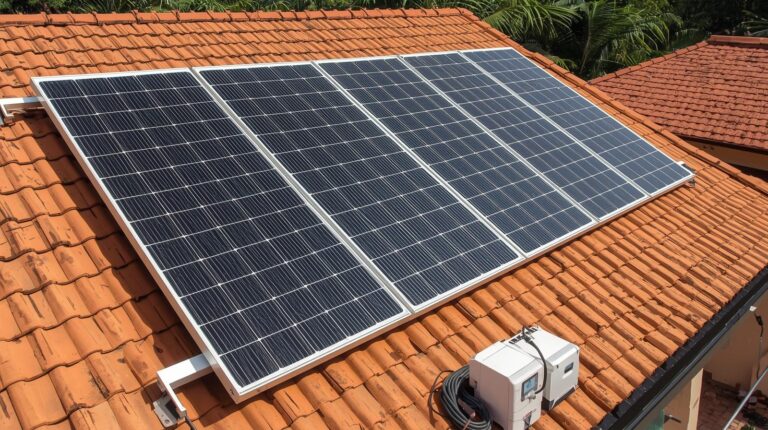As businesses increasingly aim to reduce operational costs and bolster sustainability efforts, affordable solar energy solutions for businesses present a compelling opportunity. Particularly, financing mechanisms such as solar leases and Power Purchase Agreements (PPAs) allow businesses to engage with solar technology with minimal initial outlays, paying over time based on energy usage.
Furthermore, the strategic utilization of federal and state-level incentives can greatly alleviate the financial burden of solar installations. However, the viability of these financial benefits often hinges on traversing complex regulatory environments and market fluctuations.
Understanding these dynamics is essential for businesses considering such investments, and raises the question: How can businesses optimize these opportunities while mitigating potential risks? Let’s explore to find out!
Solar Installation Cost Comparison
The national average cost for installing a 5-kW solar system in the United States is approximately $18,073, equating to around $3.60 per watt. When considering solar installation costs, it’s vital to recognize that these figures can vary widely. Factors influencing these variations include regional tax incentives, local pricing dynamics, and the competitive landscape among solar companies in different states.
To obtain the most advantageous deal, one must undertake a thorough comparison of prices offered by various providers. To effectively manage energy expenses through the adoption of solar power, prospective buyers should diligently compare prices from at least three different solar companies. This process not only helps in finding the most favorable upfront cost but also guarantees that the quality of installation aligns with expectations.
Given the substantial variation in installation costs and solar panels cost, detailed documentation and careful analysis of each proposal are imperative. This enables homeowners to negotiate better terms and capitalize on the best local pricing and available tax incentives.
In essence, liberating oneself from high energy costs involves a strategic approach to exploring solar power options, underscoring the importance of meticulous research and comparison in achieving cost-efficient energy solutions.
Solar Financing and Leasing
Exploring solar financing and leasing options provides businesses with an opportunity to adopt renewable energy solutions without the burden of significant upfront costs.
Solar financing and leasing are pivotal mechanisms that alleviate initial financial barriers, making solar power more accessible and feasible for various business models.
Solar leases represent a straightforward approach where businesses can install solar systems at minimal or no upfront costs. In this arrangement, a solar company retains ownership of the system, while the business pays a predetermined fee for the power generated, circumventing hefty initial investments.
However, businesses need to be vigilant about the lease terms, particularly concerning maintenance responsibilities and potential hidden costs.
Power Purchase Agreements (PPAs) offer an alternative, allowing businesses to pay only for the energy produced by the panels. This model eliminates upfront costs but necessitates careful consideration of long-term contract implications, which may include higher cumulative expenses.
Furthermore, community solar programs introduce an innovative model by allowing businesses to subscribe to off-site solar arrays. These programs not only extend renewable energy access to businesses lacking physical space for panels but also provide cost savings through bill credits, enhancing overall investment appeal in renewable ventures.
Tax Credits and Incentives
Businesses considering solar investments can greatly benefit from federal residential energy tax credits, which currently allow for a 30% recovery of installation costs through tax deductions. This substantial incentive reduces the financial burden of adopting renewable energy solutions, making solar systems more accessible and economically feasible.
In addition to the federal residential energy tax credit, several states bolster this advantage with their own incentives, including rebates and performance-based incentives. These can further decrease the upfront costs associated with solar installations, enhancing the overall financial viability of such projects. By reducing initial expenses, these incentives enable businesses to reallocate funds to other critical areas, promoting a more robust economic structure.
Moreover, the Production Tax Credit (PTC) offers a per-kilowatt-hour benefit for the first ten years of operation, providing a continuous financial incentive throughout the early lifecycle of the solar installation. Coupled with accelerated depreciation—allowing businesses to recover up to 60% of solar system costs in the first year—these incentives greatly improve cash flow and investment returns.
Businesses should diligently review the eligibility criteria for these incentives, ensuring compliance with requirements such as using new equipment and adhering to specified labor standards. Careful consideration and strategic planning can maximize the benefits received, solidifying the case for shifting to solar energy.
Related Post: 9 Best Solar Power Incentives for Small Businesses.
Community and Low-Income Programs
Community solar programs and low-income initiatives are vital in democratizing access to solar energy, offering practical solutions for those without the capability to install private solar systems. These programs play a significant role in making renewable energy accessible and affordable, particularly for low-income households and businesses that might otherwise be excluded from the benefits of solar power.
Key aspects of Community and Low-Income Solar Programs:
- Community Solar Programs: Available in numerous states, these allow businesses to subscribe to off-site solar arrays, reducing electricity bills through credits without necessitating on-site installations.
- Government-Supported Free Installations: Targeting low-income households, certain federal and state programs provide free solar installations, reducing or eliminating upfront costs and fostering equitable access to solar energy.
- Bulk Solar Installations: Through Solarize programs, groups can collaborate on bulk solar purchases, achieving significant discounts and lowering the barrier to entry for adopting solar technology.
- Incentives and Rebates: Enhanced by recent legislation such as the Inflation Reduction Act, these financial incentives make solar installations more feasible and attractive for economically disadvantaged entities by further lowering costs.
These initiatives are essential in promoting widespread use of solar energy, ensuring that economic status does not hinder access to environmental and financial benefits of renewable energy sources.
Evaluating Solar Offers
Evaluating solar offers requires careful examination of multiple proposals to confirm competitive pricing and ideal installation quality. To navigate through the myriad of solar panels options, businesses must scrutinize at least three proposals. This strategy guarantees a broad comparison across different installers, focusing on per-watt pricing and overall cost, which averages around $3.60 per watt in the U.S. for a typical 5-kW system.
It’s essential to identify and account for any hidden costs. Often, initial quotes exclude key elements like installation and ongoing maintenance, which can escalate the financial outlay unexpectedly. Businesses should demand thorough written quotes that detail these expenses to prevent budget overruns.
Additionally, understanding the structure of lease agreements and Power Purchase Agreements (PPAs) is important. These may offer lower upfront costs but can lead to higher overall expenditures due to lengthy contract terms.
Leveraging tax incentives, such as the federal solar Investment Tax Credit (ITC), which currently offers a 30% deduction, greatly reduces upfront investment. This financial relief, coupled with state-specific subsidies, can dramatically decrease the net cost of solar implementations, aligning energy needs with fiscal prudence while supporting environmental stewardship.
Conclusion
In summary, adopting solar energy through cost-effective methods such as solar financing, leasing, and engaging in community solar programs represents a viable strategy for businesses aiming to reduce environmental impact while managing financial resources efficiently.
Utilization of federal tax credits and state incentives further enhances the affordability of solar installations, making it a compelling option for businesses of varying scales. Careful evaluation of solar offers remains essential to guarantee the best investment decisions in renewable energy solutions.




